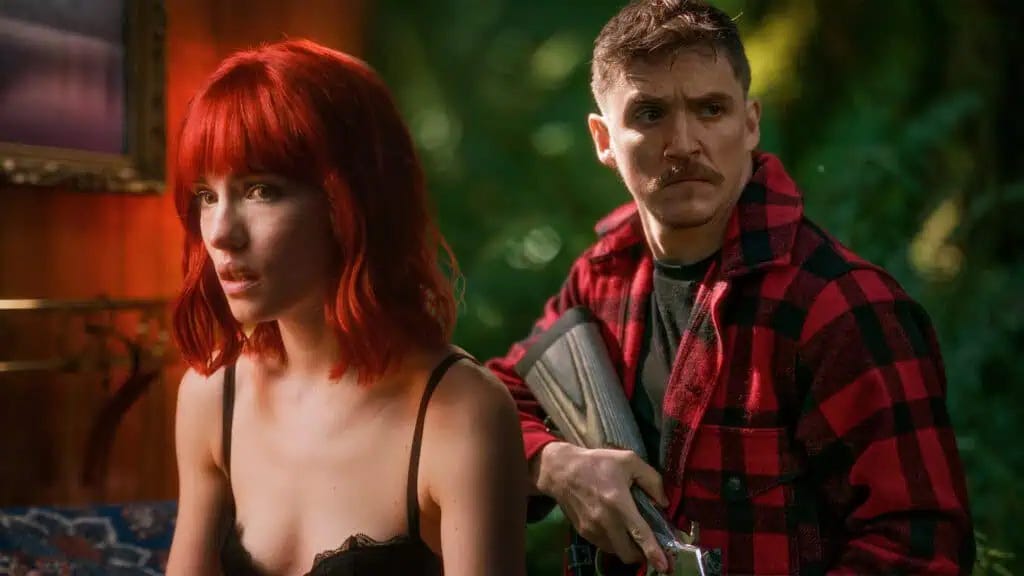Strange Darling: Unsexy and Unserious
This piece written entirely in a standard word processor, and contains spoilers for Strange Darling. There is also discussion of consent dynamics and violence.
I knew from the moment Strange Darling started with a message claiming to be shot entirely on 35mm film, I was in for a rough time. It’s a horrendously desperate film, demanding to be taken seriously (if you don’t mind thank you) entirely via meaningless marketing terminology. A vapid claim to high-art auteurism all for the sake of a limp, uninspired, and obnoxious “twist” on final girl horror.
Early reactions to the film from people like Mike Flanagan (who is burning every ounce of good will I had given him from Oculus and Hush) insisted that you must go in blind, that you’ll never guess where it goes. Strange Darling shows its hand so early that I found myself waiting for the film to go somewhere truly bizarre, to turn this whole thing on its head, but it never does. You can guess it in seconds, and the reveal comes within the first act. To be predictable is barely a sin (formulas exist for a reason), but to hinge the entire pitch of your film on a twist so obvious and run-of-the-mill that you must use a shifting, non-chronological six-chapter structure to hide it, is. The film is presented this way because it’s a hollow mess trying to mask that fact for its eternal 96-minute runtime.
If it weren’t for Hanlon’s razor I’d call this film misogynist (there is an extended sequence of who, of the two leads, should be believed in the final act that’s even more eye-rolling than it sounds), but I fully commit to calling it deeply unsexy, and not because of the nature of its anti-hero. Willa Fitzgerald plays The Lady, a woman revealed to be the serial killer known as The Electric Lady (Janelle Monae should sue) who has lured Kyle Gallner (who plays a character called The Demon, sigh) into a hotel room after a long back and forth about the dangers women have to navigate in order to enjoy casual sex. What follow is an interminable scene that consistently uses “weird sex” (see: what your conservative aunt thinks kink is) as a bait and switch to convince you that Gallner’s character is about to snap and become “The Demon” that he’s been set up to be (note that while this is happening it is already painfully obvious that he is not actually a killer). It’s a gross and dishonest method to try and wring suspense out of an audience, to use consent (and consensual non-consent) as fodder for cheap attempts at an already obvious twist.
It's a shame too, because there’s lots of competent stuff in the movie. There’s great shot composition, the coloration is fantastic, and Fitzgerald and Gallner are truly bringing their A-game. It’s a shame its in service of such a terrible script. What I find most frustrating about Strange Darling is that it is playing in spaces that are deeply interesting. What does it mean to find pleasure in danger? There’s fascinating intimacy dynamics in giving someone control over you in a consensual nonconsent situation, to relinquish control and trust someone to pick up on subtle bodily queues. If this is the way one feels physically connected to another, how does one even in engage in that kind of play casually? Is it possible? Strange Darling is interested in none of this, using it only to lie to its audience. The most egregious moment is when Gallner’s character suddenly becomes more violent after he is rebuked by The Lady, disregarding her cries to stop and actual tears, only before “flashing back” to moments before in the car when she tells him to do this. It’s a complete whiff. During the scene, Gallner grabs a restrained Fitzgerald by the throat and threatens to cut her “lips to lips”. That’s intimate, that can be sexy, and instead it’s used for cheap discomfort, a punch it immediately pulls with the aforementioned flashback. While watching, I was waiting for the reveal to be that what was set up to be a cat and mouse hunter vs hunted thriller was actually a couple’s bedroom play becoming deeply out of hand, of consensual violence spilling into the real world and affecting other, non-involved people. Silly, sure, but at least there’s something to chew on there. Turns out there’s nothing but sawdust to be found.
If there’s one scene that encapsulates the entirety of this film, where The Lady has The Demon restrained and she goes for a knife. She straddles him, her body obscuring his in the shot, as she’s implied to be going to work on him with the knife. The music swells, Gallner screams, there’s squishy noises, the works. Shortly after, it’s revealed that she simply carved “EL” into his left pectoral, a deflating, nothing act that takes the only kind of penetration in the movie and lays it out like a wet noodle, a scene that suggests and escalation that never arrives, a point that is never made.




